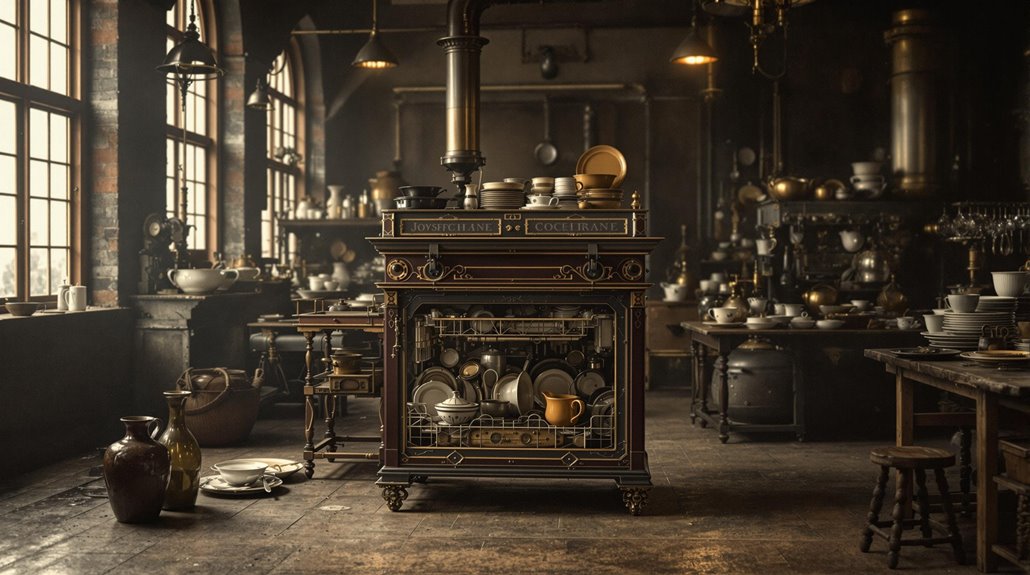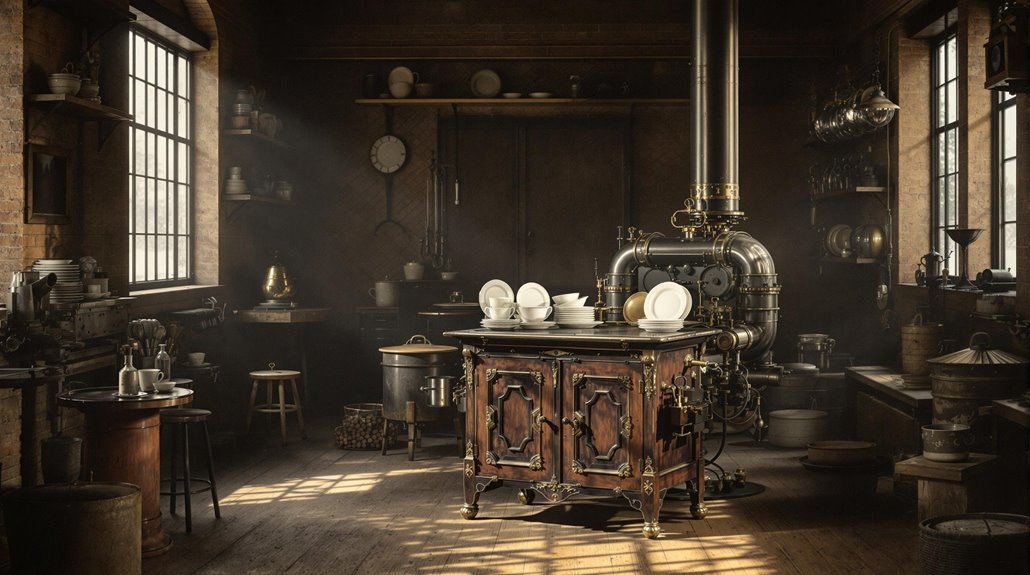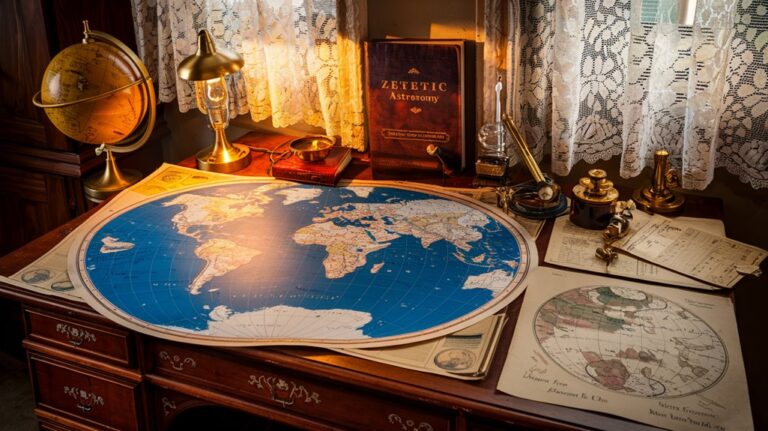Josephine Cochrane’s Big Splash: Dishwasher Tech That Upset Factory Bosses
While socialites of the 1880s focused on hosting lavish dinner parties, Josephine Cochrane was getting her hands dirty revolutionizing kitchen sanitation. You've probably never thought twice about your dishwasher, but this invention sparked a fierce battle between innovation and tradition. Factory bosses weren't ready for a machine that could clean 240 dishes in two minutes, threatening their manual labor workforce. Yet Cochrane's determination would forever change how we approach commercial kitchen efficiency.
The Socialite Who Turned Inventor
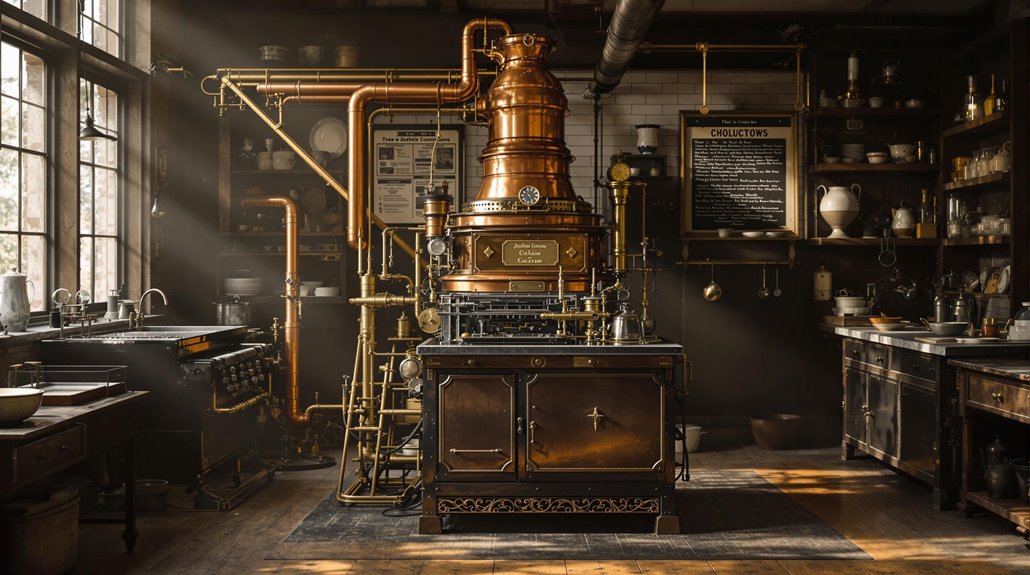
Although Josephine Garis Cochrane was born into a family of innovators in 1839 Ohio, she didn't set out to become an inventor herself. She married William A. Cochran at 19 and settled into a comfortable life as a Shelbyville socialite, hosting elaborate dinner parties with her prized collection of heirloom china dating back to the 1600s.
Her social status took a dramatic turn when her husband died in 1883, leaving her with minimal savings and mounting debt. The turning point came when she sat in her library and had an early breakthrough moment, conceptualizing the mechanical dish-washing system.
What began as frustration over servants chipping her beloved dishes transformed into a mission of necessity. Despite facing significant gender barriers, she sketched her dishwasher design and worked tirelessly in her woodshed to create a working prototype. Her invention would later achieve recognition at the 1893 World's Fair, where she showcased her innovative dishwashing machine.
She even filed her patent application as "J.G. Cochran" to avoid prejudice against female inventors.
From Chipped China to Industrial Innovation
Josephine Cochrane's path from frustrated hostess to pioneering inventor perfectly captured the spirit of American innovation. You might think her primary concern was just dishware preservation, but it went far beyond that.
Her determination to solve a common household problem led to groundbreaking domestic innovation that would revolutionize both homes and industries. Despite facing skeptical men who insisted on their own methods, she persevered with her unique design.
After her husband's death left her seeking financial stability, she tackled the problem head-on. Her ingenuity and persistence helped her secure a significant $800 order from Chicago's Sherman House Hotel.
You'll find her genius in the technical details: wire compartments, a powered wheel mechanism, and pressurized water sprays – all firsts in their field.
Unlike previous designs that relied on manual scrubbing or hand-cranking, Cochrane's creation harnessed water pressure and electric pumps to do the heavy lifting, proving that sometimes the best inventions come from personal necessity.
Manufacturing Hurdles and Commercial Success
Despite her limited technical expertise, Cochrane turned her backyard shed into an impromptu workshop where she and mechanic George Butters brought her revolutionary design to life.
Her manufacturing techniques, though basic, led to a patented design by late 1886, and she quickly established the Garis-Cochrane Manufacturing Company to scale production.
Facing significant debt after her husband's death in 1883, she persevered to make her company successful.
You'll find it interesting that her market strategies proved remarkably shrewd. Rather than targeting households, where her $75-$100 machines were too expensive and homes lacked proper hot water systems, she focused on commercial clients.
This pivot paid off when her dishwasher won top honors at the 1893 World's Columbian Exposition. Soon, she'd expanded from hotels and restaurants to hospitals and colleges, with her large models cleaning 240 dishes in just two minutes. Being related to John Fitch, the steamboat inventor, entrepreneurship ran deep in her family's history.
How Her Design Changed Industrial Kitchens
When commercial kitchens adopted Cochrane's revolutionary dishwasher, it transformed their entire operation. You'd find this innovative machine handling 240 dishes in just two minutes, making dishwashing automation a game-changer for busy establishments.
As a female Victorian inventor, she defied the social norms of her time to create this groundbreaking technology.
Her copper boiler system was instrumental in heating water to optimal cleaning temperatures, ensuring spotless results. The device's wire compartments and rotating wheel guaranteed consistent cleaning while protecting expensive dinnerware from damage.
Kitchen efficiency soared as the pressurized hot water system replaced manual scrubbing, freeing staff for other tasks. Hotels, restaurants, and hospitals quickly embraced this technology, recognizing its ability to meet strict hygiene standards while reducing labor costs.
The standardized cleaning process proved especially valuable for large-scale operations, where consistent results mattered most. You'll appreciate how this invention didn't just clean dishes – it revolutionized workflow, improved sanitation, and helped businesses serve more customers efficiently.
The Ripples of Cochrane's Legacy Today
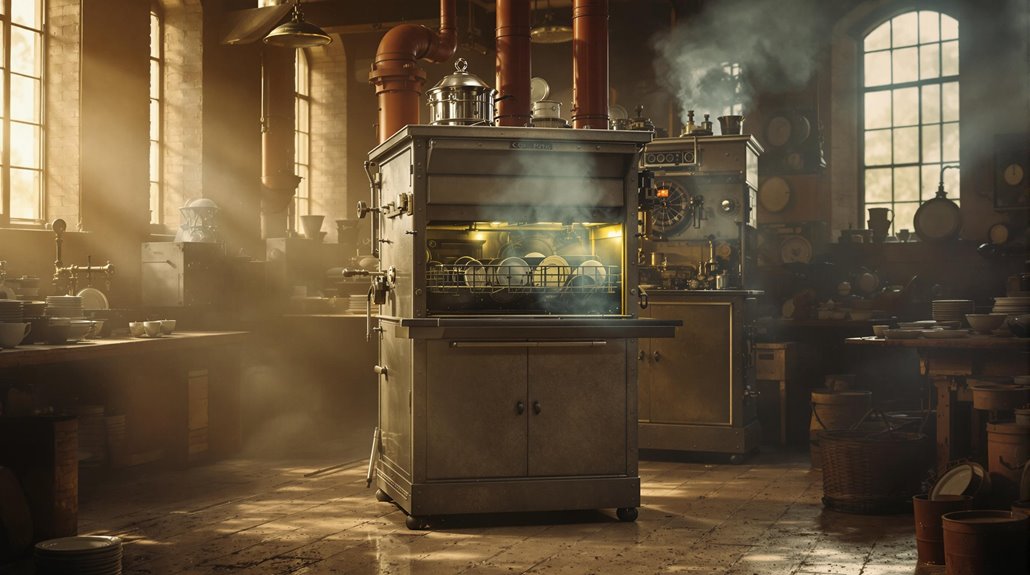
The influence of Cochrane's pioneering dishwasher design continues to shape modern kitchen technology.
You'll find her legacy in today's AI-integrated machines that select ideal cycles and smart connectivity features that let you control your dishwasher remotely.
Cochrane's influence extends beyond technological innovation to environmental consciousness. Modern dishwashers now offer touchless controls for enhanced accessibility and convenience.
Modern advancements inspired by her work now include energy-efficient designs that save up to 30% water and advanced sensors that enhance cleaning cycles.
Her invention initially focused on serving hotels and restaurants as her primary customers, before expanding to household use. Her impact on the industry remains profound – from KitchenAid's first home model in 1949 to today's eco-friendly innovations.
The 2006 National Inventors Hall of Fame induction and Romania's commemorative stamp in 2013 cement her lasting legacy.
More importantly, you're experiencing her vision every time you use your dishwasher's advanced features and water-saving technologies.

